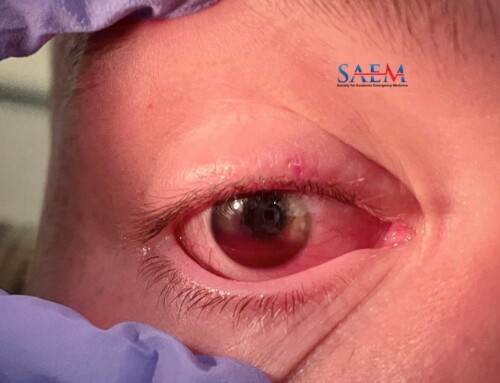 Application of fluorescein is a vital part of the workup of ocular complaints. Despite some studies showing questionable support, the typical cited clinical concern for stored fluorescein solutions is contimination with Pseudomonas and risk for iatrogenic infection with associated ulcer formation. 1–4 Subsequently, single dose sterile strips have become the standard agent stocked in most EDs. Many patients, especially children, can be apprehensive of the application of the physical strip directly to the eye, and are more comfortable with the concept of eye drops. In this post, we review multiple technique to create fluorescein solutions and additional tips for utilization that may be integrated into your practice, depending on the supplies available to you.
Application of fluorescein is a vital part of the workup of ocular complaints. Despite some studies showing questionable support, the typical cited clinical concern for stored fluorescein solutions is contimination with Pseudomonas and risk for iatrogenic infection with associated ulcer formation. 1–4 Subsequently, single dose sterile strips have become the standard agent stocked in most EDs. Many patients, especially children, can be apprehensive of the application of the physical strip directly to the eye, and are more comfortable with the concept of eye drops. In this post, we review multiple technique to create fluorescein solutions and additional tips for utilization that may be integrated into your practice, depending on the supplies available to you.
Strip-In-Syringe
This technique was first described in a guest post from Dr. Ian Brown. The strip is placed directly into the syringe, and sterile saline is drawn in with the strip. The blunt filling needle is then removed, and the solution is ready for application.

Figure 1. Strip-In-Syringe Technique
Mix-In-Packaging
This technique, utilizing a respiratory saline ampule and the strip packaging, is nicely photographed and explained in our prior post by Dr. Sam Ko and Dr. Kimberly Chan.
Dab-and-Withdraw
Another technique contributed by ALiEM-AAEM Fellow Dr Matt Zuckerman creates a solution directly in the syringe or respiratory ampule of saline. If using a 10 cc flush, you will want to discard saline until 3 cc is remaining. Saline is expressed to create a droplet at the tip of the syringe/ampule, and the strip is dabbed directly to this droplet. Aspirating brings the fluorescein solution back into the container. This will need to be repeated a few times to achieve appropriate concentration of fluorescein. Because the need for precise syringe-work, there is a potentially for small spills utilizing this technique, so plan accordingly.

Figure 2. Dab Technique. This can be performed with syringe or ampule of saline.
Specimen Cup
This is a technique I frequently utilize in my department because of the supplies that are most readily available and some messy mishaps with the above dab-and-withdraw technique. Simply dispense 3 cc of sterile solution in a sterile specimen cup, mix the fluorescein directly into the solution, and then load into syringe. We did utilize a blunt filling needle in our example, but you may load directly into the syringe if you prefer. Left over solution in the cup can be used to explain the nature of the stain and also help motivate younger patients (“This will give you super glowing eyes!”).

Figure 3. Specimen Cup Technique
Angiocath Dropper
Regardless of the technique used to create a syringe of solution, there can be some awkwardness with application. Unlike the saline ampule, the syringe has properties which make it behave unlike a typical eye dropper. Overcoming the static friction of the syringe plunger can cause a sudden stream of fluorescein solution that can be uncomfortable or surprising for patients. This can also potentially stain clothing and lessen patients overall trust and comfort in the exam setting. I have found that applying a 24G angiocath tip to the Luer-Lok syringe can help create more control applying the solution. The small droplet size has also helped me successfully stain children who were squinting, foregoing the need to pry eyelids open and cause additional discomfort and anxiety.

Figure 4. Angiocather tip assists delivery of fluorescein solution
Happy Staining!




